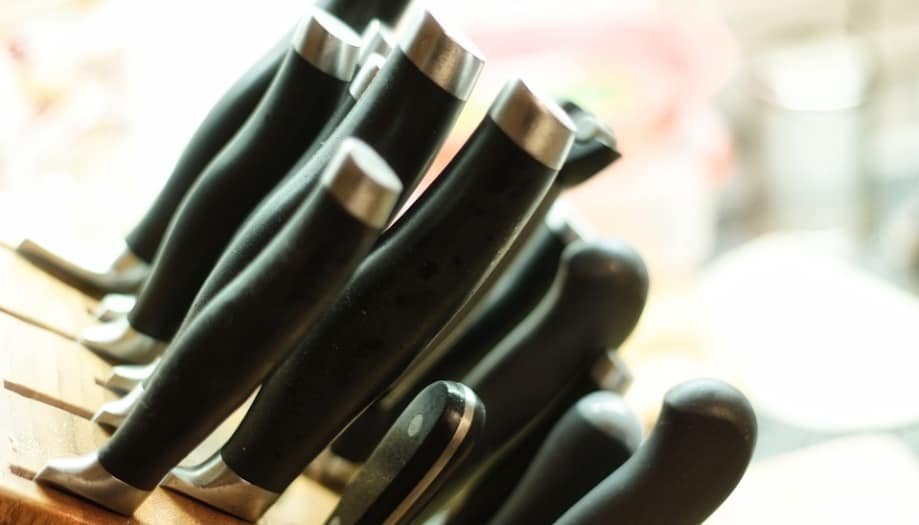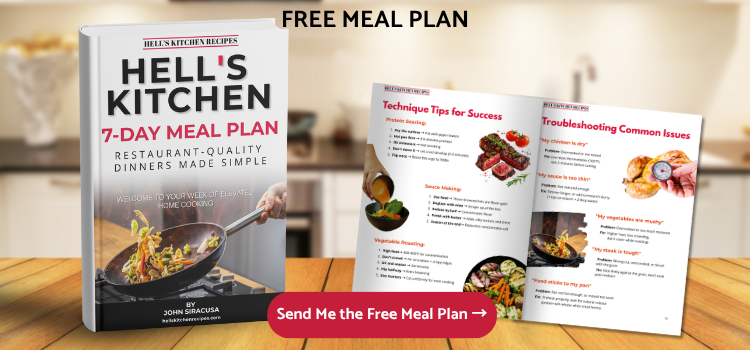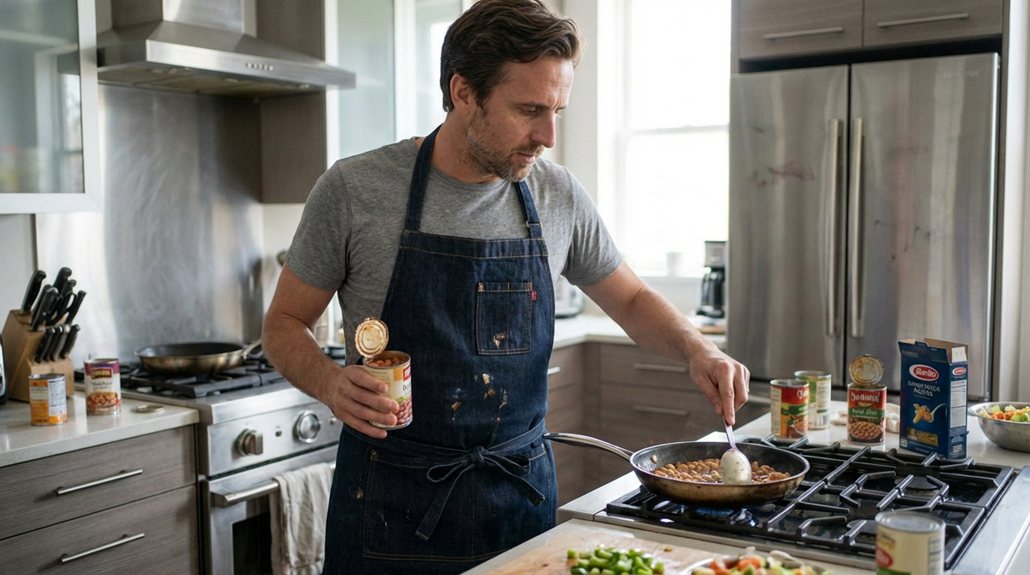Serious chefs don’t use just any German Chef knife. They consider efficiency and reliability and also take pride in renowned brands.
German knives offer these qualities in abundance, and any professional chef understands this, so their price points are relatively higher than your generic kitchen knives. They certainly deliver bang for every buck.
Due to their thick blades. German Knives will chop and dice on rigid boards and cut through hard meat without chipping or cracking.
Their metal is softer than their rivaling Japanese blades, which promotes resilience, so you don’t worry much if they accidentally fall or encounter the occasional unexpected bone.
This comprehensive guide on How To Choose German Knives will show you how to identify and distinguish authentic German knives from each other.
Isn’t it time you treated yourself to the ultimate kitchen upgrade? Don’t miss the ZWILLING Pro 16-pc Knife Block Set or WÜSTHOF Classic 15-Piece on Amazon!
Learn about What Knives Does Hell’s Kitchen Star Gordon Ramsay Use
Why Choose German Knives Brands
The famous German kitchen knife brands are or were headquartered in Solingen.
Some well-known brands originated from there include Böker knives, Wüsthof, Zwilling J. A. Henckels, Hen & Rooster, and Puma. Solingen has a long-standing reputation for producing some of the world’s highest-quality kitchen knives german made, and these brands have all played a significant role in that legacy.
Their double-beveled blades are sharpened on both sides, making them ambidextrous so they can use them indiscriminately. They are typically full tang, balancing their weight from tip to butt for easy handling.
It pairs well with their curvy ergonomic handles that conform to your grip to enhance efficiency.
Understanding the Different Types of German Knives
Ready to chop, slice, and dice like a pro? Unleash your culinary skills with the ZWILLING Pro 16-pc Knife Block Set or WÜSTHOF Classic 15-Piece. Available on Amazon!
Now that you have settled on German knives, you must find specific ones that will meet your kitchen’s needs. Legitimate German knives are high quality but specialize in different departments.
Like every other knife, consider what you lack in the kitchen and your preferences and cutting style. Let’s match a few hypothetical situations with their ideal German knives to get you going.
1. ZWILLING Professional’ S’ 8-inch Chef’s Knife
A Chef’s knife made in Germany will come in handy when you need an all-around blade for chopping and dicing vegetables, fruits, and herbs that you can also use to cut ingredients like meat, poultry, and fish.
This quality knife is typically eight to ten inches long with a curved tip that allows a rocking motion while cutting. You can also opt for a knife with a straight blade which resembles a Santoku knife.
For smaller cuts, it requires less wrist motion.

2. Henckels Forged Premio Carving Knife
A German carving knife will help you handle large cuts of meat like beef steaks, pork, or turkey. This requires a long, narrow blade for slicing through wide spaces while maintaining precision.

3. Güde Delta Bread Knife
Maybe you need a quality knife that can cut through your freshly baked loaves of bread that have a tough exterior but are soft inside without distorting their shape.
A knife with a serrated blade will tear through the hard exterior and allow you to preserve the shape of the bread. You can also use it for garnishing fruits and vegetables that are soft inside but have a hard exterior.
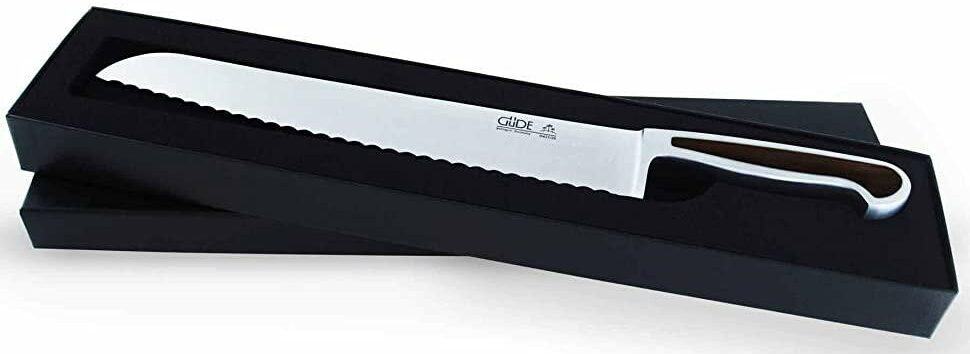
4. Henckels Classic Paring/ Utility Knife
If you need a small pointy paring knife to core and hull fruits or devein shrimp and prawns, there are many German paring knives that you can choose from. Their small profiles and sharp, pointed tips will help you remove those unwanted parts without losing chunks of precious flesh.
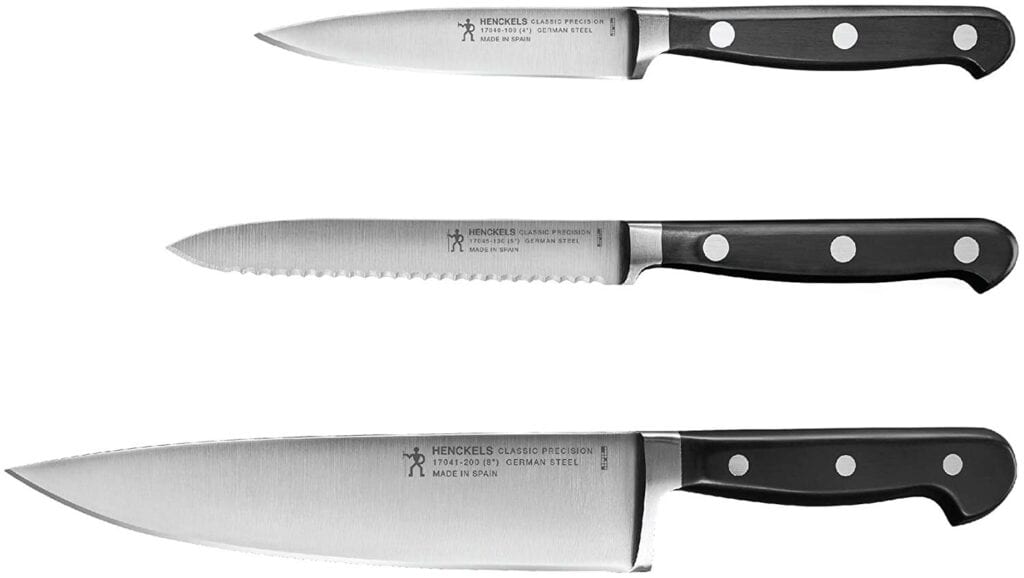
What are the most expensive German kitchen knives?
The most expensive German kitchen knife is the Nesmuk Jahrhundertmesser, priced at $95,992.60. This luxurious knife is crafted by the renowned Germany-based knife master Nesmuk.
It features premium-grade carbon steel, a wooden handle made from 5,000-year-old bog oak, and a platinum collar studded with around 25 diamonds. Post in an Article from oishya.com on April 3, 2023, “Top 10 Most Expensive Knives In The World“
What is the best German steel for knives?
German knives are typically made from high-quality stainless steel with a high chromium content, which offers protection against chipping and rust.
The steel used in German knives is relatively soft compared to Japanese knives, scoring between 56 and 58 on the Rockwell scale. Post on blog.hdmdknives.com on August 23, 2022, “The Ultimate Guide to German Knives“
Wüsthof, a prominent German knife manufacturer, uses high-carbon stainless steel in their blades.
And employs a proprietary method called PEtec (Precision Edge Technology) to make knives that are 20% sharper and last twice as long between sharpening.
Are Japanese or German knives better?
The choice between Japanese and German knives depends on personal preferences and intended usage. Japanese knives are known for their sharpness and lightweight handling.
While German knives have thicker, more durable, and more versatile blades. According to cozymeal.com, posted on April 7, 2023, “Japanese vs. German Knives: Which Is Best”
Japanese knives specialize in precise slicing and chopping. At the same time, German knives are multipurpose and easier to maintain. Choose Japanese knives for sharpness and precision and German knives for versatility and durability.
The Best German Knife Brands
While the following are not the only quality German knife brands in the market, they are some of the most established and experienced knife makers. A long list of awards and positive reviews backs them.
1. Wüsthof
Wüsthof has been making knives since Johann Abraham Wüsthof started the company in 1814. They produce their forged knives only in Solingen, Germany.
Where they can infuse high-precision production into their traditional artisanship honed for over two centuries, their iconic trident logo is now famous worldwide.
They even have an American distribution company called the Wüsthof-Trident of America Inc. To identify a genuine Wüsthof knife blade, check below the spine towards the bolster.
The proclamation “Made in Solingen, Germany will be below it.” it will have the Wüsthof logo (a trident in a circle) engraved on it, followed by the brand name and the series name.
Their full-tang blades are cut from a single block of martensitic stainless steel, which has exceptional corrosion resistance and polishes well, maintaining the sleek, elegant look.
Its high carbon content boosts mechanical capabilities by making them stronger without significantly impacting its weight. A lifetime warranty covers this German Chef knife set.
2. Zwilling
This brand is one of the oldest in the world right now. The Zwilling trademark was registered with the Cutlers’ Guild of Solingen by their founder, Peter Henckels, in 1731.
It has close to three centuries of existence. Zwilling is the German word for twin, and the logo features two people, presumably twins, holding each other’s shoulders. The registration was done on June 13 and governed by the zodiac sign of Gemini.
Production of Zwilling knives is monitored to standardize quality across their plants. They quickly earned a reputation for producing high-quality knives.
Their products were winning world fair awards as early as 1851. They have maintained the tempo by infusing advanced technologies into their processes.
They enjoy a brand presence in every important market in the world. Their knives are produced in Germany and Japan, and they have distribution companies in over twenty countries to cater to their global demand.
Eighty-five percent of sales for the year 2021 came from outside Germany. Their full-tang blades are created in line with their SIGMAFORGE structure, which involves the precision forging of a single piece of a special Germa high-carbon stainless steel formula.
The resultant blade is strong and has no weak points. Zwilling knives are then taken through their patented FRIODUR ice-hardening process, producing blades with excellent cutting-edge retention and enhancing flexibility and corrosion resistance.
A lifetime manufacturer’s warranty covers them.
3. J.A. Henckels International
This brand has been around since 1895 and has various cutlery and kitchen tools to its name, including some of the best knives in the world.
The same reputed company owns Zwilling and JA Henckels brands. The difference between the two is in the price and the materials used. Henckels is the entry version,
While Zwilling is a premium knife, high production quality and standards are maintained in all their factories.
4. Messermeister
This company started in 1981 as a distributor of German and Japanese products under the name DAMCO (Dressler American Marketing Company). Bernd Dressler founded it. They changed their name to Messermeister in 1985 when they launched their first exclusive Messermeister knife design.
It is a fully woman-owned outfit led by Dressler’s wife Debra and their daughters Kirsten and Chelsea. They deliver knives, kitchen accessories, and award-winning culinary tools.
They have redefined traditional German knife designs over the years; they introduced a demi-bolster design that enabled sharpening the knife’s entire edge from the heel to the tip.
They also reduced the sharpening angle to fifteen degrees, the lowest for German-style knives, making the Messermeister the sharpest German knife.
5. Güde Alpha
In 1900, Karl Güde started forging knives from single pieces of steel in Solingen. They grind the knives, fit the handles, and hone them by hand.
They were, and still are, some of the best products of Solingen. Güde is famous for developing the back-set serration used in bread knives.
They still produce handcrafted knives and remain true to drop forging, which is now enhanced with ice-hardening that improves the structure of the German blades.
They use stainless steel alloys infused with chrome and molybdenum, which are tough, corrosion-resistant, and durable.
Want to make your kitchen more than just a place for cooking? Add a touch of class with the ZWILLING Pro 16-pc Knife Block Set or WÜSTHOF Classic 15-Piece. Find it on Amazon today!
How Can You Be Sure They Are True German Knives?
There is an avalanche of brands in the current knife market, and they typically claim their products are sharper, can maintain an edge, and are well-balanced and durable.
Going by the same reasoning, many knife manufacturers have adopted the claim that their knives use German stainless steel as a marketing tool. It is either German steel, a German knife blade, or a German knife.
The fascination with kitchen knives made in Germany can be attributed to the world-renowned brands captured throughout this article that has produced quality, high-grade knives for centuries in Germany.
Their impact has left the impression that German steel is the best for knives, which marketers use. (This is not based on any actual comparison with steel from other parts of the world.)
Final Thoughts: Why German Knives are a Cut Above the Rest
While it is true that these German powerhouses continue to produce some of the finest knife specimens, the terms can be misleading, and you should be vigilant. Get insights into Which Wusthof Knife Set & Collection Is Right for You?
The term “German stainless steel” can be used for steel constructed using German formulas, not necessarily in Germany. Check out Cutco vs. Wusthof Knives
With the manufacturers’ inclination to lower the cost of production, factories in countries without regulations might skimp on materials and produce inferior-quality blades.
Without sufficient amounts of vanadium, chromium, nickel, and other elements which make the blades rugged, your German knives will be brittle and fragile.
Buy knives manufactured in Germany or distributed by the actual manufacturer. This holds them accountable for the quality. If you want a slightly lower price tag, check out established brands like Mercer Culinary.
They have mastered the production of the best German knives and have proven they can take advantage of low labor costs without compromising quality. These measures guarantee you the full protection of any manufacturer’s warranties offered.
Upgrade your kitchen game now! Grab the exquisite ZWILLING Pro 16-pc Knife Block Set or WÜSTHOF Classic 15-Piece on Amazon today!
